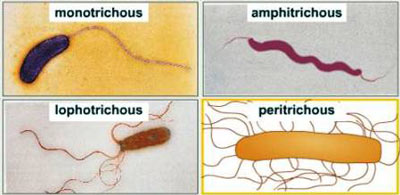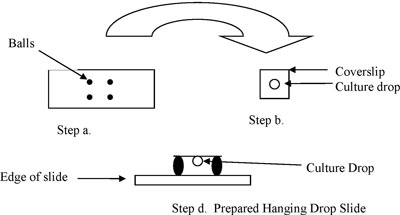The Hanging Drop Slide Technique to Study Bacterial Motility
In this exercise you will learn to make hanging drop slides and then use this technique to observe the motility of living bacteria.
Motility is an important characteristic used to identify microorganisms. Three bacteria will be used which vary in size, shape and arrangement of flagella, and types of motion. Specifically you will observe Pseudomonas aeruginosa, a monotrichous bacterium that exhibits high motility using a polar flagellum, Bacillus cereus that moves by peritrichous flagella and Spirillium volutans, a helical cell that moves using large bipolar tufts of flagella (possible mixture of amphitrichous and lophotrichous organisms) (refer to Figure 1).
Flagellae are, in effect, rotary motors comprised of a number of protein rings embedded in the cell wall. In action the filament rotates at speeds from 200 to more than 1,000 revolutions per second, driving the rotation of the flagellum. The direction of rotation determines the movement of the cell. Counterclockwise rotation of polar flagella thrusts the cell forward with the flagellum trailing behind. Periodically, the direction of rotation is briefly reversed, causing what is known as a "tumble" resulting in reorientation of the cell.

Figure 1: Images of various flagella.
In this lab you will:
- Prepare three hanging drop slides and use aseptic technique to apply the three bacterial suspensions to slides.
- Observe and draw the microbes in your Lab Notebook.
- Prepare a simple stain of each microbe.







